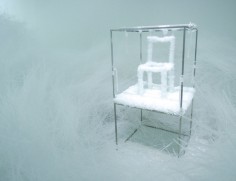TOKUJIN YOSHIOKA
吉冈德仁
吉岡徳仁
Spider’s Thread

source: stylepark
Born in Japan in 1967 and the winner of a large number of awards, with pieces on display at the MoMA and the Cooper Hewitt in New York, the Victoria & Albert in London and the Vitra Design Museum. Tokujin Yoshioka trained along with Shiro Kuramata and Issey Miyake, opened his own studio in 2000, and has worked with Japanese and international companies such as Hermès, Toyota, BMW and Swarovski, designing showrooms and installations. As a result of the success of the Honey-pop paper chair in 2001, he began establishing increasingly close links with the world of interior design, developing projects for Driade, Moroso and Kartell, amongst others. The signature feature of his creations is their poetic, light, dreamlike quality; his products, interiors and installations are the result of painstaking, complex research carried out on simple materials, combined with experimental technology. The awards he has received include Design Miami, Designer of the Year 2007, the Wallpaper Design Awards 2008 and Elle Decoration International Design Award, Designer of the Year 2009.
.
.
.
.
.
.
source: ideafixa
O ano de 2009 foi recheado de inusitadas aplicações de novas tecnologias. A primeira década do milênio foi sem dúvida marcada pela solidificação do termo “multimídia” e para quem acompanha Tokujin Yoshioka, 2010 será feito de sutilezas e bom design. Nascido em Saga, Tokujin teve uma breve, porém importante, passagem pelos estúdios de ninguém menos que Yssey Miyake. Tokujin vem desenvlvendo em seu escritório, desde 2000, trabalhos de arquitetura e design para diversas marcas do segmento fashion. Destaco aqui duas de suas realizações em 2009. A primeira uma instalação para a vitrine da Maison Hermès/Japão. Em um momento do ano em que lojas nos expõem a um clima exagerado de “Espírito Natalino”, nos afogando em neve falsa e glitter, dar de encontro com uma “obra” dessas seria como cair em um oásis de serenidade.
.
.
.
.
.
.
.
source: jiajusina
摘要:吉冈德仁1967年出生于日本南部九州岛的佐贺县(Saga),在当地传统工艺和民俗的熏陶下,年幼时的吉冈德仁就已经确立了未来成为一名设计师的志向。1983年,吉冈德仁进入东京的桑泽设计学校(Kuwasawa Design School)学习室内设计和工业设计,并在这里遇到了对他有知遇之恩的老师,已故日本设计大师仓俣史郎(Shiro Kuramata,1934-1991)。
学生时代的吉冈德仁就有一个让人惊讶的生存技能——竞赛,在东京学习期间他居然靠不断赢取大大小小的竞赛养活了自己。1986年毕业后,吉冈德仁开始在仓俣史郎的事务所工作;1988年,在仓俣史朗的推荐下,吉冈德仁来到了另一位日本设计大师三宅一生的事务所工作,虽然吉冈德仁从未接受过任何有关解剖学或者服装设计的专业训练,但他对人体的平衡、运动、感觉,甚至情感都有着与生俱来的感悟力,三宅一生回忆说:“我早就知道,只要我几天没见吉冈君,当他忽然出现在我眼前的时候,总能给我看一些‘好东西’。他带给我的从来就只有惊喜。”
这种“惊喜”的感觉,几乎在吉冈德仁的每件作品中都能体会到。
.
.
.
.
.
.
.
source: hastaladesign
Mineral crystals grown on thin threads form the shape of a chair in this installation by Japanese designer Tokujin Yoshioka. Tokujin Yoshioka created the Spider’s Thread sculpture of a chair by suspending just seven filaments within a frame that was sat in a pool of mineral solution. The solution was drawn up the threads and gradually formed into crystals around them, fleshing out into the shape of a piece of furniture.
The project is a development of Yoshioka’s earlier Venus chair, where crystals were grown on a sponge-like substrate. Spiders
“Spider’s Thread applies the structure of natural crystals in an advanced way aiming to produce a form even closer to the natural form,” said Yoshioka. The designer says this iteration references a traditional story by Japanese writer Ryunosuke Akutagawa. “The Buddha takes a thread of a spider in Heaven and lowers it down to Hell so that the criminal can climb up from Hell to Paradise,” explains Yoshioka. “In the story, the thread of a spider is a symbol of slight hope and fragility.” The piece is on show as part of a solo exhibition called Tokujin

